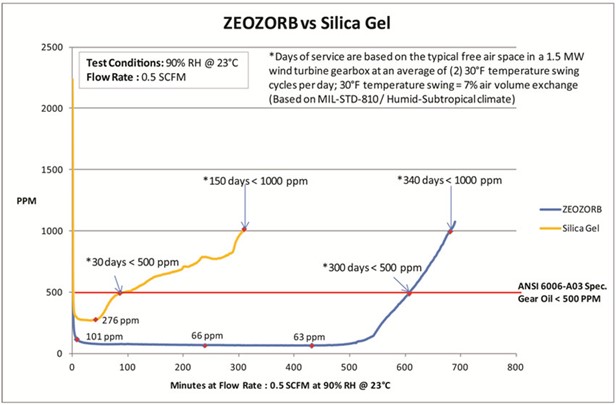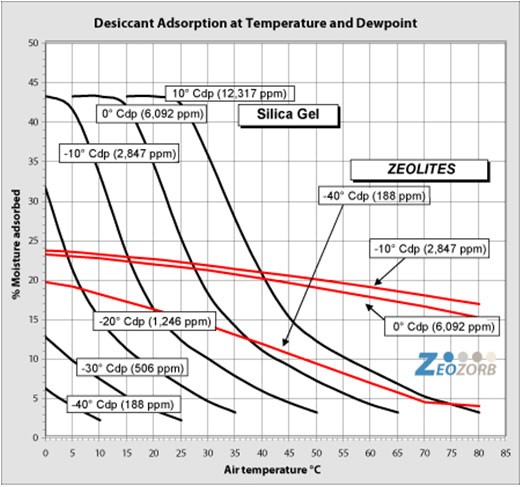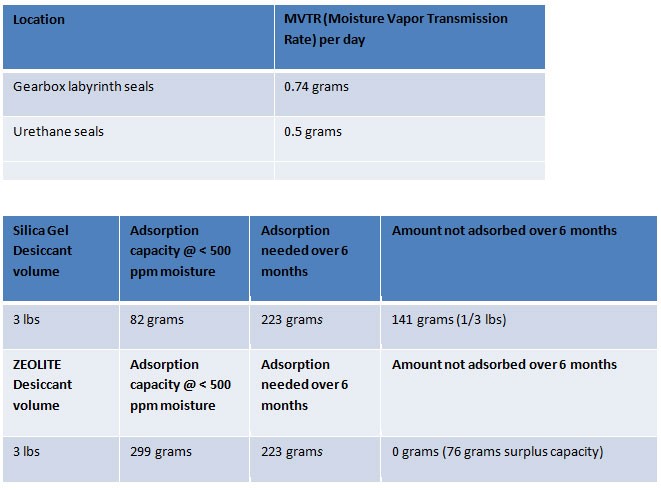
Within the past few years, the growing emphasis on proper operations and maintenance procedures has created a need for better solutions to protect major wind turbine components – in particular, gearboxes and transformers. Instances of gearbox failures and downtime continue to plague the industry and its users. As the industry progresses, wind turbines are beginning to be placed in harsher environments such as tropical climates, arctic climates, and offshore which will exacerbate maintenance issues.
Some of the most susceptible components are the gearbox drive system, power transformers, bearings, and hydraulic systems. Properly maintaining clean lubricating oil is proven to be one of the best preventive maintenance practices an operator can make. Three major factors influence the quality and cleanliness of a lubricant – monitoring, removing, and excluding contaminants.
Removing contamination, in particular moisture and particulate, is more difficult than preventing it in the first place; it costs about ten times more to remove contamination than to prevent it. Preventing the contaminants is the best option and this is where new solutions should be considered.
During their beginning development phase, wind turbines used a basic breather vent to filter out particulate from incoming ambient air, but nothing to filter out moisture from ambient air. AWEA/ANSI/AGMA 6006-A03 F.5.3.3.2 standard states that gearbox lubricating oils should be kept under 500 ppm, parts per million, moisture. Water in excess of this standard can lead to lubricant degradation, degradation of internal components, corrosion of metallic components, accelerated metal fatigue, accelerated additive depletion, accelerated oxidation, and can interfere with an active lubricant film formation. Until now, the solution has been the use of silica gel desiccant breathers, but even their performance is very limited.
Lessons can be learned from the Aerospace and Defense industry, where maximizing performance in the harshest environments has been the status quo of daily operations. Moisture control solutions are vital for proper operation of various military and aerospace systems. These moisture control solutions have one thing in common, ZEOLITE. Currently within the wind energy industry, silica gel breathers are the standard to protect against moisture contamination, however silica gel is not the highest performing desiccant available. There is a common misconception within the industry about a desiccant’s adsorption capacity by weight. For example, the highest performing indicating silica gel can adsorb up to 33% by weight, where ZEOLITE can adsorb up to 27% by weight; therefore, it appears silica gel is the better option. This is simply not the case. Although silica gel adsorbs 33% by weight, the actual dew point, or PPM level, achieved is limited to around 250 ppm and can only achieve this level in a very narrow operating temperature range. Above 25°C silica gel performance drops off drastically, whereas ZEOLITE can provide a significantly lower PPM level; less than 100 ppm at a very wide operating temperature range.

In addition, silica gel’s higher 33% adsorption capacity is a bit of an unfair claim since that capacity should be equated to a specific temperature and PPM level achieved. For example, a silica gel providing dry air at 10°Cdp (12,317 ppm) at 30°C will adsorb 36% by weight, and a ZEOLITE providing dry air at 10°Cdp (12,317 ppm) at 30°C will adsorb 23% by weight. While silica gel does indeed have a higher adsorption % by weight, it only provides relatively “dry” air, 10°Cdp (12,317 ppm). Let’s look at a scenario where we would exceed the ANSI 6006-A03 F.5.3.3.2 standard of less than 500 ppm moisture. A silica gel providing dry air at -40°Cdp (188 ppm) at 10°C will adsorb 3% by weight, and a ZEOLITE providing dry air at -40°Cdp (188 ppm) at 10°C will adsorb 18% by weight. In a scenario where silica gel is being used and temperatures exceed 10°C the desiccant will not adsorb any moisture; therefore ZEOLITE desiccant should be used as it maintains 5-20% adsorption capacity throughout almost any temperature condition while exceeding the ANSI 6006-A03 F.5.3.3.2 specification of less than 500 ppm moisture.

After reviewing testing results, ZeoZorb Inc. can conclude that ZEOLITE significantly outperforms silica gel in any environment, but what does this mean for the industry? The company took a closer look and tested the headspace air dynamics of gearbox lubricating oils. After analyzing several gearbox lubricating oils with Karl Fischer Titration testing, the results were interesting. (See chart 1).
Test 1: New ISO 320 Gear Oil tested
Test 2: ISO 320 Gear Oil Saturated under the following conditions: 80% RH @ 75°F for 88 hours
Test 3: “Test 2 Saturated Gear Oil” conditions: 96 hours in DRYKEEPER box with ZEOLITE
Test 4: New ISO 320 Gear Oil conditions: 96 hours in DRYKEEPER box with ZEOLITE

The test results show that samples significantly increased in PPM level under test “saturation” conditions. In Test 3, where ZEOLITE desiccant was used, the specimen from Test 2 dropped dramatically in PPM level. In Test 4, where ZEOLITE desiccant was used again, the specimen from Test 1 NEW OEM gear oil dropped significantly. This is a very crucial dynamic that proves by keeping the free air headspace above lubricating oil in a gearbox or reservoir at a low enough PPM level it will liberate moisture within the lubricating oil itself. ZEOLITE desiccant should be the industry standard, as its performance is superior to silica gel and will even condition gear oil over its use.
Reducing operations and maintenance costs have been widely debated, and one suggestion is to extend operations and maintenance intervals beyond the 6-month industry standard. To accomplish this goal, operators must ensure the size of the breathers being used in their application is sufficient. One solution is to use a manifold to allow for multiple breather use simultaneously. Depending on the environment, and free air volume within a gearbox or reservoir, maintenance intervals could be extended beyond 2 years. Looking closer, it appears that silica gel breathers are being saturated or fully spent well before their 6-month life span.
Example: Typical air inhale into a 10 ft 3 gearbox free air head space under a diurnal temperature swing of 30°F. Based on MIL-STD-810.

At the end of the day, desiccant breathers are still a disposable commodity and longer-term solutions should be developed. With the advancements of wind turbine technology, turbines are being placed further offshore, where operations and maintenance costs increase exponentially. Not only do wind farm owners need to pay for technician labor, but additional fuel and transportation costs make 6-month maintenance intervals cost prohibitive. Long term regenerative moisture control systems should be considered.
Currently, there are a few regenerative solutions in the industry, all which use silica gel. Silica gel has been the preferred choice when selecting a medium to be regenerated because silica gel will regenerate when baked at 195°F. This low reactivation temperature is attractive as there are many options to generate a temperature of 195°F, but each time silica gel is reactivated it loses a percentage of its drying capacity.
One alternative would be to reactivate ZEOLITE which guarantees better adsorption performance in all environments and temperatures. ZEOLITE is much harder to reactivate, but thankfully the need for these technologies has already been developed within the Aerospace & Defense industry. One of these technologies is a propriety Self- Regenerating Filter System (SRFSTM), developed by ZeoZorb Inc., which provides a constant blanket of dry purge air, less than 10 ppm moisture. This can contain a gearbox, reservoir, and many other applications. The SFRS system requires a power connection and is maintenance free for 5 years.
As the wind industry continues its astonishing growth, OEMS and wind farm operators should explore new and innovative technologies to provide more robust operations and maintenance programs.
